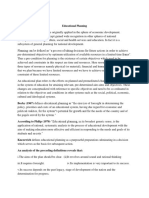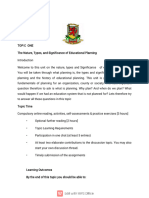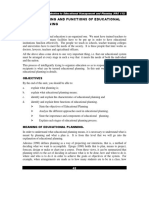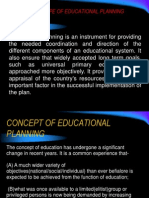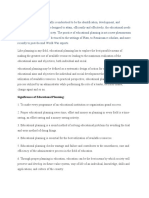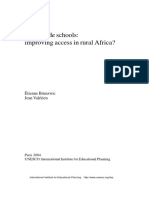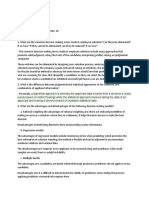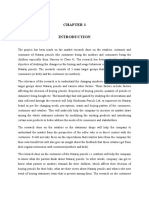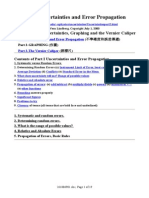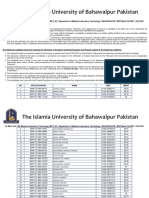Educational Planning HIPDET (Dr Selfor)
Uploaded by
Selfor GastianEducational Planning HIPDET (Dr Selfor)
Uploaded by
Selfor GastianCourse Facilitator: Dr Selfor Gastian Mbifornyi
email [email protected]
School: Higher Institute for Professional Development and Training (HIPDET)
Bonaberi Campus
Field of Study: Education
Specialty: Education Management, Administration and Planning
Level: Masters
Course Title: EDUCATIONAL PLANNING (EMAP 5104)
Credits: 4
Course Objectives:
By the end of this course, the student administrator will be able to define planning
and educational planning, and also examine the various management and planning
systems currently in use in organizations
Course Contents:
The content of this course will include:
1. Basic concepts of planning and educational planning
2. Purpose and structure of educational planning
3. Educational planning process.
4. Current management and planning systems in vogue such as MBO, PERT,
PBBS, Delphi Technique etc;
5. Relationship between economic and educational planning
6. Approaches to educational planning
7. Basic principles of educational planning
8. Problems facing educational planning/possible solutions.
Assessment
SN Mode Mark
1 Class Participation/ Attendance 10
2 Written test/Assignments 20
3 Final Examination 70
Total 100
Some References
Adams, D., & Bjork, R. M. (1969). Education in development areas. New
York, NY: David McKay.
Bennis, G.W. (1966). Changing organizations. New York, NY: McGraw
Hill.
Bicanic, R. (1967). Problems of planning, east and west. The Hague,
Netherlands: Mouton.
Bierstedt, R. (1950). An analysis of social power. American sociological
review, 15(6), 730-738. Blau, P.M., & Scott, R.W. (1962) Formal organization: A
comparative approach. San Francisco, CA: Chandler Publishing.
Burke, F. G. (1965). Tanganyika preplanning. Syracuse, NY: Syracuse University
Press. Cartwright, D. (1959). A field theoretical conception of power. In D.
Cartwright (Ed.), Studies in social power (Ch. 11). Research Center for Group
Dynamics, Institute for Social Research, Ann Arbor,
MI: University of Michigan. Correa, H. (1969). Quantitative methods of
educational planning. Scranton, PA: International
Textbook.
Dahl, R.A. (1957). The concept of power. Behavioural Science, 2(3), 201-
215.
Dror, Y. (1963). The planning process: A facet of design. International
Review of Administrative Science, 29(1), 46-56.
Dror, Y. (1968). Public policy making re-examined. San Francisco, CA:
Chandler Publishing.
Emerson, M.R. (1962). Power-dependence relations. American sociological
review, 27, 31-41.
Ewing, D. W. (1969). The human side of planning. New York, NY:
Macmillan.
Inbar, D. E. (1974). The paradox of feasible planning. Unpublished
manuscript, School of Education, Hebrew University of Jerusalem, Israel.
King, J.A. (1967). Economic development projects and their appraisal:
Cases and principles from the experience of the World Bank. Baltimore, MD:
Johns Hopkins Press.
Lasswell, H. D. (1959). A study of power. Glencoe, IL: The Free Press.
Lasswell, H. D. (1962). Power and personality. New York, NY: The Viking Press.
Parsons, T. (1969). Politics and social structure. Glencoe, IL: The Free
Press.
Polanyi, M. (1958). Personal knowledge. Chicago: University of Chicago
Press.
Russell, B. (1938). Power: A new social analysis. London, England: George
Allen & Unwin.
Simon, H. (1957). Models of Man. New York, NY: John Wiley.
Smith, R. W. (1973). A theoretical basis for participatory planning. Policy science,
4(3), 275-296.
Tawney, R. H. (1931). Equality. NewYork, NY: Hartcourt, Brace.
United Nations Educational, Scientific and Cultural Organization International
Institute for Educational Planning (UNESCO IIEP) (1967). New Educational
media in action: Case studies for planners, I, II, III.
Paris, France: UNESCO.
United Nations Educational, Scientific and Cultural Organization
International Institute for Educational Planning (UNESCO IIEP) (1967). The new
media: Memo to educational planners. Paris, France: UNESCO.
Waterston, A. (1965). Development planning: Lessons of experience. Baltimore,
MD: Johns Hopkins Press.
UNIT ONE: BASIC CONCEPTS IN PLANNING AND
EDUCATIONAL PLANNING
Introduction to Planning
There is a huge gap between the formulation of a plan and its implication. Often it
is intensely difficult to bridge. Implementation is the Achilles’ heel (weakness or
vulnerable point) of educational planning. Even when a plan is rational, comprehensive,
coherent and consistent, its implementation may well be partial, slow and
inefficient. And the end result may even be inferior to what would have been
expected in the absence of any plan (Waterson, 1965). In the words of Dror (1963),
planning is “a process for preparing a set of decisions on which future action is to
be based”. Since decisions effectively determine policy (Lasswell & Kaplan,
1965), planning involves the entire process of bringing about a particular course of
action, and may be defined as the process consciously oriented toward future
change of the present situation.
According to Marx and Musaazi, planning is ‘a rational process of preparing
a set of decisions for future actions directed at achieving goals and objectives by
optional means.’ We can decipher planning as a futuristic, goal-oriented activity
from this definition. Planning requires there to be specific goals and objectives as it
cannot take place in a vacuum. The process of planning is not only concerned with
objectives; it is concerned with the means of achieving these objectives as well.
Thus, we can say that planning is concerned with the implementation of these
objectives.
According to Ovwigho (1991), ‘planning is a process that involves the
selection of facts and assumptions that are related to the future with the aim
of visualizing and formulating the desired outcomes to be attained.
Concepts of Planning
Planning is a fundamental management function that involves setting objectives
and determining a course of action for achieving those objectives. It is crucial in
both personal and organizational contexts. Here are some basic concepts in
planning:
1. Objectives/Goals: Clear, measurable targets that an organization or individual
aims to achieve. Objectives provide direction and purpose in the planning process.
2. Strategies: Broad approaches or methods that outline how to achieve the set
objectives. Strategies can be long-term and focus on overall mission and vision.
3. Tactics: Specific actions or steps taken to implement strategies. Tactics are
short-term and often more detailed than strategies.
4. Resource Allocation: Determining how to distribute available resources
(financial, human, technical, etc.) to achieve the objectives. Effective resource
management is critical for successful planning.
5. Timeframes: Establishing deadlines for achieving objectives. Planning often
involves setting both long-term and short-term timelines to track progress.
6. Flexibility and Adaptability: The ability to modify plans in response to
changing circumstances, new information, or unexpected challenges. Effective
planning requires a degree of flexibility.
7. Risk Assessment: Identifying potential obstacles and uncertainties that could
impact the success of the plan, along with strategies to mitigate those risks.
8. Implementation: The execution phase of the planning process, where the plan
is put into action. This involves coordinating resources and ensuring that all parts
of the organization understand their roles.
Educational Planning
The concept of educational planning can be misleading if distinction is not made
between its different forms. It is a generalized concept, which comprises different
planning processes, and different tactical aims based on different forms of
knowledge, all leading to the differential use of social power. There is a common
denominator underlying a structural reform of the education system, location of
school sites, rezoning, curriculum-planning, educational innovation, and the
introduction of educational technology. All are included within the provision of
educational services and have the same general aim: improved education for the
benefit of man and society. However, quite different planning processes are
involved. One principal difference is the interrelationship of uncertainty,
flexibility, plan-duration and scope.
Different types of plans have different degrees of uncertainty, and such
implicit differences in uncertainty will influence plan flexibility. The degree of
flexibility explicitly introduced into a plan must be proportionate to the degree of
uncertainty about future events. The degree of implicit flexibility of the
plan can be defined as the degree to which its nature and content (i.e., the
characteristic of its unique set of decisions) are interrelated, so that reaching a
decision determines the direction in which later decisions go.
As such interdependence increases, implicit flexibility determining the
implementation process will decrease. We define the degree of explicit flexibility
introduced into a plan as the degree to which feedback mechanisms are built into it,
enabling choice to be made between alternative courses of decision
and action during the implementation process. Obviously, explicit flexibility is
limited. And, equally, it is related to the flexibility inherent in the nature of the
plan. Consequently, different educational planning exercises imply enforcement
through different implementation processes.
Planning may seem to be simple to understand, however educational
planning is still a mystery to many. Further, the modern conception of
educational planning has attracted specialists from many disciplines. Each of them
tends to see planning rather differently.
The following are some of the most popular and accepted definitions of
educational planning.
1. Anderson and Bowman (1967) defined educational
planning as ‘the process of preparing a set of decisions for future action
pertaining to education’.
2. Williams (1971) defined educational planning
simply as ‘Planning in education, as in anything else consist essentially of
deciding, in advance, what you want, to do and how you are going to do it’.
3. According to Bernardo M. Reyes (1974)—Educational planning is an
instrument for providing the needed coordination and direction of the
different components of an educational system and ensures that widely
accepted long-term.
Therefore, Educational planning could be defined as a process through
which as set of decisions concerning the educational enterprise are taken in
such a way that the goals and objectives of education are achieved given the
available human and financial, and material resources.
Concepts in Educational Planning
Educational planning involves the systematic process of setting educational goals,
determining the means to achieve them, and allocating resources efficiently to
enhance the educational system's effectiveness. Here are some basic concepts of
educational planning:
1. Goals and Objectives:
- Vision and Mission: Establishing a clear vision and mission for the educational
institution or system is crucial. This guides all planning efforts.
- SMART Objectives: Setting specific, Measurable, Achievable, Relevant, and
Time-bound goals helps ensure that educational plans are concrete and actionable.
2. Assessment of Needs:
- Needs Analysis: Evaluating the current educational landscape, including
student demographics, teacher qualifications, and community needs, is essential to
identify gaps and prioritize areas for improvement.
- Data Collection: Using qualitative and quantitative methods (surveys,
interviews, performance data) to gather information about existing conditions.
3. Curriculum Development:
- Curriculum Design: Planning involves designing a curriculum that aligns with
educational goals and meets the needs of learners.
- Instructional Methods: Selecting appropriate teaching strategies and learning
resources that facilitate effective student learning.
4. Resource Allocation:
- Budgeting: Allocating financial resources appropriately to support educational
programs and initiatives.
- Human Resources: Planning for the recruitment, training, and professional
development of educators and staff to ensure quality teaching.
5. Implementation Strategy:
- Action Plans: Developing step-by-step plans to implement the curriculum,
interventions, and support services identified in the planning phase.
- Timeline: Establishing a realistic timeline for execution ensures that all
stakeholders understand when various phases will take place.
6. Monitoring and Evaluation:
- Performance Indicators: Establishing criteria to measure the effectiveness of
educational programs and policies.
- Feedback Mechanisms: Implementing systems to gather ongoing feedback from
students, teachers, and other stakeholders to inform future planning and
adjustments.
7. Stakeholder Engagement:
- Collaboration: Involving various stakeholders, including teachers, parents,
students, and community members, in the planning process fosters ownership and
accountability.
- Communication: Ensuring clear communication about the goals, strategies, and
expected outcomes of educational planning is vital.
Purpose of Educational Planning
Educational planning serves multiple purposes that are essential for the effective
management and improvement of educational systems. Here are some key
purposes of educational planning:
1. Goal Setting: Educational planning helps in defining clear and measurable
goals for educational institutions, ensuring that all stakeholders have a common
understanding of the desired outcomes.
2. Resource Allocation: It allows for the optimal allocation of resources—such as
budget, personnel, facilities, and instructional materials—ensuring that they are
used efficiently and effectively to support educational objectives.
3. Strategic Development: Planning facilitates the development of strategies to
achieve educational goals, whether it's enhancing curriculum quality, improving
student outcomes, or integrating technology into teaching and learning.
4. Assessment and Evaluation: By establishing benchmarks and indicators,
educational planning provides a framework for assessing progress toward goals,
allowing for ongoing evaluation and adjustments to improve performance.
5. Adaptation to Change: Educational environments are subject to changes in
technology, societal needs, and economic conditions. Planning enables institutions
to proactively respond to these changes, ensuring they remain relevant and
effective.
6. Inclusion and Equity: Through thoughtful planning, educational systems can
address issues of accessibility and equity, ensuring that all students, regardless of
background or circumstance, have the opportunity to succeed.
7. Workforce Development: Educational planning encompasses the alignment of
educational programs with labor market needs, helping to prepare students for
future employment and contributing to economic development.
8. Community Engagement: Effective educational planning often involves
collaboration with community stakeholders, ensuring that local needs and values
are reflected in educational offerings and policies.
9. Long-term Vision: It helps provide a long-term vision for the future of
education, including the development of infrastructure, technology integration, and
evolving educational practices that align with future societal needs.
10. Risk Management: Planning involves identifying potential risks to
educational goals and devising strategies to mitigate these risks, ensuring the
sustainability of educational initiatives.
By addressing these areas, educational planning plays a crucial role in
shaping effective, equitable, and sustainable educational systems that meet the
needs of learners and society as a whole.
Characteristics of Educational Planning
The concept of educational planning has been evolving since the first usage
of the term in early 1950s. The modern concept of educational planning
endures the following main characteristics:
1. Cooperation: Modern educational planning emphasizes involvement,
contribution and participation of different concerned segments of the society
in the process of planning. Only when people from all the walks of life would
be involved in the educational planning would it be an accepted and fruitful
affair.
2. Remedial Measure: The main objective of educational planning is the
identifying cause of the educational problems and suggesting relevant
solutions.
Thus, educational planning should be remedial and guidance-oriented.
3. Choice of Best Alternative: The elementary kinds of procedure were not as
logical, systematic and scientific based as is the modern concept of educational
planning.
4. Team Work: Modern educational planning emphasizes that not only the
top administrator or the government but a team comprising of individuals
from different sections of society should be involved in planning. Therefore,
a group of responsible people or experts in their own fields should set goals
and plan an efficient and effective way to achieve them. Planning is not the
responsibility of one person but the each and every person should be
concerned with the process of change.
5. Social and Economic Goals: The focus of educational planning should
be the social and economic goals, which should be aimed at betterment of
all citizens without any discrimination. The goals set by society along with
the needs of students should be the main point of reference.
6. Scientific Changes: Modern educational planning believes in objective
collection, interpretation and analysis of data. The analysis is intended to
present the interrelationships between present and future needs. Further, an
attempt is made to interpret and analyze the data so as to establish
interrelatedness of the various components of the social and educational
system.
7. Anticipation: The modern concept of educational planning is expected to
be sensitive to developments and needs in future much ahead of time, so as
proper facilities, supporting media and required resources for implementing
the planned change may be secured.
Questions:
UNIT TWO: BASIC PRINCIPLES OF EDUCATIONAL PLANNING
Educational planning is of extreme importance as it forms the basis of all
projects related to the development of education, i.e., the quantitative and
qualitative improvement in education. The working principles of educational
planning are as follows:
1. Proper formulation: Educational planning needs to have a perfect
formulation. The procedure and processes should be carefully formulated,
unified and systematically carried out. Its objective must be clear.
Coordination and integration needs to be developed among various
components, activities, teams of people involved in the planning. All the
activities of planning finally should be carried out methodically.
2. Element of national planning: Educational planning should be
recognized and carried out as an integral element and aspect of national
planning. It is widely known that social and national development can be
achieved through a well-developed system of education. Thus, the activities
and programmes of education must take into account the overall national
development. Hence, educational planning has to be accepted as a primary
and essential part of total national planning. Therefore objectives, activities,
programmes, procedure of educational planning should be determined in the
larger context of national planning.
3. Ongoing and unremitting process: Educational planning has to be a
continuous process requiring constant modification and adaptation of plans
to meet the regular and emergency needs. There can be no plan which can
be considered final, rigid and perfect. The plans may need changes any time
in future depending upon new situations, conditions and circumstances and
other exigencies. The plan when prepared should have in-built flexibility
and adaptability to meet emergency needs.
4. Functional, pragmatic and practical: The plans developed should be
workable and must be such as it can be implemented. The plans should be
realistic and feasible. It should conform to the situational realities and at the
same time adaptable to future requirements. The plan should aim to achieve
the objectives in the circumstances and conditions which are obtained there.
5. Based on research: Any kind of planning works best if it is based on
sound research. Similarly, educational planning should be based on
systematic research and the decisions involved in the plan should not be
arbitrary or intuitional. The final choice of the alternatives should be
warranted by factual information and results of objective research. Plans
based on objective and systematically carried out research have better chances of
meeting the objectives.
6. Active continuing participation of interest groups and organizations:
Implementation of the plans at different stages would command
involvement of many people and several groups in any kind of organization.
Involvement of these people may contribute significantly to more functional
and practical decision-making. If the people are involved in planning, they
are expected to have a greater sense of identification with the plan and at the
same time would be better motivated to implement the decisions contained
in the plan. A cautionary note here is that this participation of interested
groups and person should not be limited to early stages but should be
continuous at all stages.
7. Result in specific recommendations which are understood and
accepted by participants: The plan should not offer guidelines but specific
and descriptive recommendations of what is to be done, why is it to be done,
how is it to be done. They should be self-explanatory so that people who are
involved in its implementation may understand what they are required to do.
They should be comprehensive enough to be understood and implemented.
8. Continuing evaluation of the planning process: The plans should not
be considered as things which are fixed, they should be ready for evaluation.
Frequent assessment of different components enables future adaptation of
the plan according to changing conditions.
9. Meeting the needs of the people: Educational planning is done with the
intention of meeting the needs of the country or people. Hence the social,
manpower and economic needs of the nation among others have to the centre
of all considerations.
10. Needs-based and situation oriented: There cannot be a single best plan
for all purposes and all times. Each plan would have a unique character
which would be determined by the needs of the situations. Specific and
unitary plan can be prepared to solve immediate problems. Similarly, short term
and long-term plans may be prepared.
Elements of Educational Planning
Educational planning takes into account the past and present realities of the
country’s education and training programmes. It is commonly preceded by
a survey of the educational situation and needs. Well-organized statistical
services are necessary to provide essential and reliable data. According to
Reyes, the essential elements of educational planning are as follows:
1. Quantitative Planning: This covers all questions involved in the
expansionof educational facilities based on pedagogical, demographical
geographical, economic, and social factors. Quantitative planning makes
references to school population (enrolment, dropout and promotion), the
recruitment of teachers and supervisors, and the provision of classrooms and
equipment (furniture, laboratories, and so on).
2. Qualitative Planning: This covers aims, content, and methods of
education, in particular the structure of educational systems, curricula
planning (by levels and branches), curricular planning (the levels and
branches), teacher training, educational guidance, research, and textbooks
and other teaching aids.
3. Administrative Planning: This is concerned with the needs and assets,
costs, sources or finance, distribution of expenditures (recurrent
expenditures and capital investments), grants, and loans. It dwells in detail
with the administration of education, covering national, provincial and local
administration as well as school administration and supervision. It is
concerned with problems of personnel, and administrative structure and
procedures. Thus, all matters relating to the aims, content and means of
education, all of which are closely interrelated and largely conditional on
each other, are assembled and classified, allowing of more systematic and
efficient distribution and coordination of the work.
Understanding the three types of planning
The basic distinction between the three types of planning processes is
the time phase. Activities or objectives are set in problem. Each type of
planning moves the planning process towards the fulfillment of the school’s
mission.
1. Problem-solving planning: A problem-solving plan should have a life
span of not more than two months. The process involves:
- Identifying a problem that adversely affects the routines performance
of a school.
- Selecting an appropriate strategy for resolving the problem.
- Outline, controlling and evaluating activities and carry out the plan
within 30-60days.
- Planning unit administrators who permit a problem to last for more
than 2months have out-leaved their usefulness within the school
organization. When strategies long-range planning and operational.
Short-range planning has become well enthranged, there should be
less need for problem solving planning.
2. Operational planning: Operational, tactical or short-range planning
covers a period of several months to a year and it is implemented to improve
routine or daily conditions in the school. It is the process of identifying a
need, setting short-range objectives, detailing performance standards and
describing an action planner. This type of planning usually involves a greater
number of school personnels than problem-solving or strategic planning.
3. Strategic planning: Strategic or long-range planning has a long time
phase than operational and problem-solving planning, and may cover a
period between three and ten years. Strategies are matched with needs to
arrive at the best approach to the mission and educational goals of a school.
Basically strategic planning is the process of realizing the school
organisations missions, long range goals and strategies governing the use
of human and non-human resources needed to achieve the mission. This type
of planning is much more dynamic than operational planning and much
more in need of a vision if drastic changes in the internal or external
environment of the school occur. It deals with more uncertain variables
about the future of a school and therefore requires a more in-depth study of
planning variable and new opportunities than either problem-solving or
operational planning strategic. Planning for creativity in determining the
most effective use of resources. The cost for solving-problems should be a part of
the operational budget.
Benefits of planning or advantages of planning
Planning helps in the following:
- To avoid the waste of resources or it helps in maximizing the use of
scarce resources.
- To avoid surprises
- To increase the probability of achieving intended goals
- To have a sense of direction or focus
- To make improvement possible
- To be pro-active rather than reactive (i.e., you correct an error before
things get bad than trying to correct when things are already bad). The
plan can modify or adjust or completely in case something is
scent to be very wrong.
- Planning can lead to control and check
- It prevents waste of time or lead to managing the time well.
Steps in the planning process
1. Problem identification or programme identification
2. Goals and objectives are stated very clearly
3. In doing the above, the planner and weaknesses relative to being able to
accomplish the goals.
4. Develop assumptions or promises a hypothesis.
5. Identify alternatives or options among which to choose the most feasible.
6. Implement the best option of your plan.
7. Evaluate the plan to see if it has succeeded or fail.
UNIT THREE: APPROACHES TO EDUCATIONAL PLANNING
There are three types of approaches to educational planning as
Follows:
- The social demand approach
- The man power requirement approach
- The cost benefit analysis approach
1. The social demand approach: This can be defined as the provision by
the state of schools and related facilities for all pupils or students who
request admission or who are qualified to entered. It amounts on the one
hand to a calculation of what the situation in respect to cost, supply of
teachers, plant and resources and school leader output will be at the end of
a specified planning period if existing school provision remain more or less.
It is and what will be require if the various kinds of social demands were
attained.
Advantages of the Social Demand Approach
(i) It is a suitable supporting political tool to meet the need to satisfy the demands
of the general public.
(ii) The approach provides the planners with most appropriate number of places
where educational facilities have to be provided.
(iii) This kind of planning techniques are most suitable where resources are
acutely limited, and such kinds and quantities of education are planned
which will offer the greatest good to the greatest number.
Limitations of the Social Demand Approach
(i) The approach in no way has a command over factors like price of
education.
(ii) The approach has no power to manage the absorption of trained
personnel in the economy. (iii) The approach is poor in the sense that it does not in
any way lay claim to whether the resources expended are economically
prearranged.
(iv) The approach does not provide any kind of guidance as to how best to meet the
identified needs.
2. The manpower requirement approach: The manpower: it can be
defined as the analysis of the skilled manpower requirement and the
economy from which a calculation is made of the quantities, kinds and level
of education required to meet them. The manpower requirement has been
apply to educational planning by Parnes (1962), Harbison and Myers (1964),
Tinbergin (1964). Parnes distinguish between projections and forecasts projections
can be defined as the attempts to foresee the conditions that resolve from the play
of spontaneous economic forces. Forecast can be defined as the attempts to
spell out the implication of target output figures when economic
development in being deliberately manipulated by the state.
Advantages of Manpower Approach
(i) According to this approach, education holds a significant position in the
country’s economy and majorly contributes to the nation’s growth,
emphasizing the necessity of education.
(ii) Manpower approach does not need sophisticated statistical studies and
can easily point out the extreme gaps and disparities in the education output
pattern that need necessary antidotes.
(iii) Since the approach focuses on manpower needs of a country, it
effectively guides educators and policy makers on how roughly educational
qualifications of the labour force ought to be developed in the future.
Limitations of the Manpower Approach
(i) Manpower approach may overemphasize the notion of unemployment
and underemployment, which may become a challenge to move towards
the
right kind of education which may be development-oriented, and thereby
creating its own job.
(ii) (ii) Educational planners in this approach get a limited guidance in the
sense that it does not tell what can be actually achieved in every level of
education, i.e., primary education, secondary education, etc.
(iii) Since primary education, the first step of education is not considered
to be work connected; manpower approach suggests the curbing of the
expansion of primary education until the nation is rich enough to expand
it.
This is not a healthy sign for any country because it is primary education
which lays the foundation of a developing nation.
(iv) The approach gives a biased view of manpower needs, which are
mostly focused on the urban setting. Thus, the planner may not give due
attention to education requirements of semi-skilled and unskilled workers
in the cities and vast majority of workers that live in rural areas.
(v) It is nearly impossible to make a fairly reliable forecast of manpower
requirements far enough ahead of time because of many economic,
technological and other uncertainties which are involved, especially in a
rapidly changing world.
(iii) 3. The cost-benefit analysis or cost effectiveness or rate of return: It
can be defined as the systematic comparism of the magnitude of the cost
and benefit of some form of investment in order to access its economic
profitability. This is providing a major of expected yields of investment
as a guide to efficient allocation of resources. As a result, this approach is
cost and benefit orientated and emphasis is place on limited resources.
Advantages of Rate of Return Approach
(i) It is possible to measure or quantify the increase in productivity of an
educated person, using this approach, by looking at the age earnings
structure of the educated person.
(ii) (ii) It shows the connection between the cost of gaining more education
and the increase in imbursement which results from additional education.
(iii) The analysis can show or propose the directions in which e
system of a society should expand so as to maximize the earning
competence of its citizens.
Limitations of Rate of Return Approach
(i) At times ‘salaries reflect productivity’ may be a wrong
assumption.
(ii) It is not easy to quantify the advantages that are obtained from
investing in any type of education.
(iii) Differentials in the workers’ income cannot be accredited to
additional education acquired in developing countries. It can be
attributed to other aspects like family background, habits,
primordial factor and customers.
(iv) Some studies are of the view that primary education provides
the highest return to the society on the basis of calculation of
social return rates for all education levels. However, this
approach does not agree to the same.
(v) Certain complexities are present in this type of planning as it
needs to clarify and work out the educational investment that
needs to be made and its corresponding returns—returns in the
form of benefits that are gained by the individual and the society
as a whole. The method to measure the benefits of individuals
and society is rather difficult.
Revision Question:
Educational planning can be approached from three perspectives:
social demand, manpower demand and rate of returns. Examine
each
of these approaches. (20pts)
UNIT FOUR: SOURCES OF REVENUE
Despite a shortage of financial resources and high production
developing appropriate a substantial ament of funds to education. The
financing of education in Cameroon like elsewhere is multifaceted. There is self-
financing, financing by the state, financing through donations and endowments of
all this sources public finance (financing by the state) is the major source of funds
of education.
1. Public financing: The state provides finances implicitly as well as
explicitly (state budgetary allocation). There is implicit financing of
education through the provision of land and building even in private schools, the
level of provision of subsidized is high. In fact, government is the major single
source of fund for education. The three rationales usually presented within the
standard theory of public finance for the state financing of education are:
a. To promote general stabilization of the economy.
b. To encourage a more equitable distribution of the products of the
economy.
c. To improve their locative efficiency of the production system.
In other words, government subsidizes education in order to:
1. Under investment (since the social benefits of education exceeds private
benefits.
2. For reasons of fairness or equity and equality of education. If education
was provide under market conditions only those who can afford to pay
tuition fee will enroll not only will they be under investment from the social
part of view out income. In equalities will be preserve from one generation
to the next since education is, itself a deter of life time income.
3. Because many people believe that education is subject to economies of
scale and thus that it is more efficient to finance and provide education
publicly. Education can be regarded as a government investment, as well as a
private and social investment. Since government subsidies education and in
return derive high tax revenue from the educated.
2. Self-financing: Things and fees that parents pay for children when going
to school. Tuition has been important source of revenue for education both
for the private and public schools. Besides tuition fees, self or private
financing of education also takes the form legislation or examination fees
and purchase of books, materials and special clothing such as uniforms, as
well as the indirect cost of earnings or income foregone.
It has been argued that education is a highly profitable personal
investment hence it must be pay for by the individual or his/her family. The
expected benefit (from education) more than compensate for the burden of
high cost. The private rate of return help to explain why for e.g. there is still
strong private demand for education in developing countries were educated
unemployment is prevailing. i.e. in developing countries like Cameroon.
People were there is no employment people still want to be educated.
3. Private gifts and grants: Especially private institutes depend heavily on
gifts and grants from philanthropic foundations and to a diminishing degree
religious orders. Business cooperation also make gifts to institutions. Other
sources of gifts are:
- Individual such as trustees, ex-students, faculties and friends. What
can be said about the motives for voluntary financial support of
institutions or why do all this people support institutions?
Intuitively it is easy to say that cooperate giving is a form of advertising aim
at image making and creating goodwill.
Foundation giving can be explained in terms of the purpose of these
organizations and it may vary according to special interest such as the
generalized philanthropic goals of the founders. Religious contributions are self-
explanatory; to favour development and support of parochial religion. The motives
of individuals probably fall into two categories:
➢ One group of individuals mainly alumni can be said to be repaying
the institution for the implicit grants enjoyed while they were in
school i.e. the motive is gratitude and loyalty.
➢ Other individuals may have more selfish motives. E.g. a person vie
like say a hotel school it should never be void of the rent can be used
for the interest of schools.
4. Donations and endowment: Income from financial investment of
endowments is one of the source of revenue used in the financing of
education. It is true that, endow usually result from gifts, the income from
these endow gifts, not the gifts themselves is a real source of fund, for the
financing of education. In other words, endowments provide funds through
the earnings resulting from financial investments in the form of dividends,
interest, capital gains and various forms of rents, royalties and net income
from commercial business activities. It is money that has been given to a
school, college or university to be held in perpetuity. The principal usually
may not be send but the income may occasionally the endowment income
may be use for particular purposes.
5. Community involvement: Another private source of educational support
is the community contribution. Some countries have attempted to overcome
financial constraints by using direct labour to build schools. By allowing
communities to provides goods and services in kind rather than cash
payment and by relying on other forms or local community involvement or
self-help.
Local communities may undertake to build a school for example or to
provide good and services in kind (such as food or accommodation for
teachers). It is difficult to major the value of such contributions but so far
such indirect financing represents only a small part of the total cost of
education in most developing countries. Some interesting efforts have been
made to explore such local resources however or to have students contribute
towards the financing of their schools through direct labour for example, by
producing goods for sale.
3.) “There are different sources of revenue for the financing of
education”
justify this statement which was made by a principal of a school
during a planning meeting with her staff (20pts).
UNIT FOUR:
CURRENT MANAGEMENT AND PLANNING SYSTEMS IN
VOGUE SUCH AS MBO, PERT, PBBS, DELPHI TECHNIQUE
There exist management and planning systems currently used in the world.
Management by Objectives (MBO)
MBO is a strategic management model that focuses on setting specific, measurable
goals with employees and aligning their objectives with the overall goals of the
organization. While MBO was developed in the 1950s by Peter Drucker and has
evolved over the years, its core principles remain foundational in current
management practices.
Characteristics of MBO
Here are some attributes of the current management and planning systems that
draw inspiration from MBO or have evolved alongside it:
1. Goal Alignment: Modern organizations often use frameworks that encourage
alignment between individual, team, and organizational goals. This ensures that
everyone is working towards common objectives.
2. SMART Goals: The principles of setting SMART (Specific, Measurable,
Achievable, Relevant, Time-bound) goals are widely adopted in contemporary
goal-setting processes, enhancing clarity and accountability.
3. Performance Metrics: Current systems often incorporate KPIs (Key Performance
Indicators) and OKRs (Objectives and Key Results) as tools to measure progress
toward goals, emphasizing data-driven management.
4. Employee Involvement: Like MBO, contemporary management practices
emphasize the involvement of employees in the goal-setting process. This
engagement improves motivation and commitment to achieving set objectives.
5. Regular Reviews and Feedback: Regular performance reviews and feedback
sessions are crucial in modern management, allowing for adjustments to goals and
strategies in real-time and ensuring accountability.
6. Flexibility and Adaptability: With the rapidly changing business environment,
current management systems encourage flexibility in objectives, allowing for
pivoting and reassessment of goals as circumstances change.
7. Focus on Collaboration: Many modern management frameworks emphasize
teamwork and collaboration, promoting cross-functional goals and emphasizing the
importance of collective achievement.
8. Integration of Technology: Today’s management systems often leverage
technology for tracking progress and performance. Software solutions can facilitate
real-time updates, collaborative goal setting, and performance analytics.
9. Emphasis on Personal Development: In addition to organizational goals, there is
a growing focus on personal development and career growth as part of the
objectives-setting process, aligning individual aspirations with organizational
goals.
10. Agile Management Techniques: Many organizations are adopting agile
methodologies that, while not strictly MBO, incorporate similar principles.
Advantages of MBO
MBO is a strategic management and planning system that focuses on aligning
individual performance with organizational goals. It involves defining objectives
for employees and managers, creating a clear path to achieve those objectives, and
regularly assessing performance. Here are some key advantages of the MBO
approach:
1. Clarity of Objectives: MBO promotes clear, specific, and measurable objectives
for employees at all levels. This clarity helps individuals understand their roles and
contributions to the organization's goals.
2. Improved Performance: By setting clear objectives and regularly reviewing
progress, MBO can enhance employee motivation and performance. When
employees know exactly what they are working towards, they are more likely to
stay focused and engaged.
3. Enhanced Communication: The MBO process encourages open communication
between managers and subordinates, fostering a collaborative environment.
Regular check-ins and feedback improve understanding and alignment on
objectives.
4. Empowerment and Accountability: MBO gives employees a degree of autonomy
in deciding how to achieve their objectives. This empowerment can lead to greater
job satisfaction and ownership of work, as employees take accountability for their
results.
5. Alignment with Organizational Goals: MBO ensures that individual objectives
are aligned with the broader goals of the organization. This alignment helps to
create a unified direction, minimizing conflicts and misunderstandings.
6. Focus on Results: MBO emphasizes results and performance outcomes,
encouraging a results-oriented culture. This focus helps the organization prioritize
efforts and resources effectively.
7. Performance Measurement: MBO allows for the establishment of specific
performance metrics and targets, which can be used to evaluate both individual and
organizational success. This data-driven approach helps in making informed
decisions.
8. Regular Feedback and Assessment: The MBO framework typically includes
regular evaluations of progress toward objectives. This helps identify areas for
improvement and enables timely adjustments to strategies and tactics.
9. Motivation and Morale: Setting achievable targets and recognizing employee
contributions can enhance motivation and morale. Celebrating achievements
reinforces a positive culture and encourages continued performance improvements.
10. Facilitates Professional Development: MBO can identify training and
development needs, allowing organizations to invest in employee growth, which
can lead to enhanced skills and capabilities.
Challenges of MBO
While MBO can enhance focus and align efforts toward organizational goals, it
also presents several challenges. Here are some key challenges associated with
MBO management and planning systems:
1. Goal Misalignment: One of the core issues with MBO is that sometimes
individual objectives may not align with organizational goals. If employee
objectives are not properly aligned with the broader business strategy, it can lead to
fragmented efforts and reduced overall effectiveness.
2. Rigidity: MBO systems can sometimes become overly rigid as teams and
individuals may feel compelled to meet specific objectives, even when
circumstances change. This rigidity can stifle creativity and innovation, as
employees may stick to their targets rather than adapting to new information or
changing market conditions.
3. Focus on Quantitative Metrics: MBO often emphasizes measurable objectives,
which can lead to an overemphasis on quantitative metrics at the expense of
qualitative aspects like employee morale, teamwork, and customer satisfaction.
This might result in an environment where employees prioritize numbers over
overall performance and values.
4. Inadequate Communication: Successful MBO requires continuous
communication between managers and employees. If there is a lack of effective
communication regarding objectives, feedback, and progress updates, it can lead to
misunderstandings, misaligned expectations, and disengagement.
5. Employee Resistance: Employees may resist MBO systems if they feel that the
objectives are unrealistic, overly burdensome, or not aligned with their personal
growth aspirations. This resistance can lead to a lack of motivation and decreased
morale.
6. Short-Term Focus: MBO can sometimes lead to a focus on short-term objectives
rather than long-term strategic goals. Employees may prioritize achieving
immediate targets, potentially sacrificing longer-term growth and vision.
7. Time Consumption: The process of setting, monitoring, and evaluating
objectives can be time-consuming. Managers may need to spend significant time
on administrative tasks related to MBO, which can detract from time spent on
higher-value activities like coaching and team development.
8. Lack of Flexibility: In rapidly changing business environments, the goals set out
in an MBO system are fixed and does not make room for a lot of flexibility.
Program Evaluation Revie Technique (PERT)
PERT is a project management tool designed to analyze and represent the tasks
involved in completing a given project. While PERT is still utilized, particularly in
fields requiring complex project management, several contemporary management
and planning systems have emerged, often incorporating digital technologies and
methodologies. Here are some noteworthy systems and methodologies that are
currently popular in project management and planning:
Methodologies or Systems in PERT
1. Agile and Scrum:
- Agile is a methodology that promotes iterative development, where
requirements and solutions evolve through collaboration between cross-functional
teams.
- Scrum, a framework under Agile, involves defined roles (Scrum Master,
Product Owner, Team Members) and uses time-boxed iterations called sprints.
2. Kanban:
- Kanban is another Agile methodology that emphasizes visualizing the work
process, limiting work in progress, and enhancing flow. It uses boards to track
tasks as they move through various stages.
3. Critical Path Method (CPM):
- Similar to PERT, CPM focuses on the longest path of tasks necessary to
complete a project and identifies the shortest time possible to complete the entire
project, thereby determining which tasks are critical.
4. Waterfall Model:
- This traditional sequential approach to project management involves distinct
phases where each must be completed before moving on to the next. It's still used
in software development and other fields, especially when requirements are well-
understood upfront.
5. Integrated Project Management (IPM):
- IPM combines various project management methodologies and tools to unify
project information, often utilizing software solutions for better integration.
6. Project Management Information Systems (PMIS):
- These software tools facilitate project planning, scheduling, resource allocation,
communication, and documentation. Examples include Microsoft Project, Jira,
Trello, and Asana.
7. Earned Value Management (EVM):
- EVM is a project management technique used to assess project performance
and progress by comparing planned progress to actual progress and considering
costs.
8. Hybrid Approaches:
- Many organizations employ a hybrid approach, combining methodologies such
as Agile and Waterfall, tailored to fit specific project.
Advantages of PERT
PERT as a project management tool used to analyze and represent the tasks
involved in completing a given project has the following advantages.
1. Visual Representation: PERT provides a visual representation of the project
timeline and the interdependencies between tasks, making it easier for project
managers and team members to understand the project flow.
2. Focus on Timelines: PERT emphasizes the time required for each task and the
overall duration of the project, helping to identify critical paths and areas where
time can be saved.
3. Flexibility: PERT can accommodate uncertainty in project scheduling by
allowing project managers to estimate task durations using optimistic, pessimistic,
and most likely time frames, which can be particularly useful in complex projects.
4. Identification of Critical Path: By identifying the critical path – the longest
sequence of dependent tasks – PERT helps project managers to pinpoint which
tasks are crucial to meeting project deadlines.
5. Enhanced Communication: The process encourages communication and
collaboration among team members since it requires input from various
stakeholders, fostering a more cooperative work environment.
6. Resource Optimization: PERT helps in optimizing the use of resources by
indicating which tasks can be done simultaneously and which cannot, thus
allowing for better allocation of time and resources.
Disadvantages of PERT
1. Complexity: PERT can become quite complex, especially for large projects with
many tasks and dependencies. This complexity can make it difficult for
stakeholders to follow and can require a significant amount of time to set up.
2. Time and Effort Required: Developing a PERT chart can be time-consuming.
Gathering accurate estimates for task durations and constructing the diagram can
require significant effort from project managers and team members.
3. Reliance on Estimates: The accuracy of a PERT analysis is heavily reliant on the
quality of time estimates provided for tasks. Inaccurate estimates can lead to
misleading results and poor project planning.
4. Limited Focus on Costs: While PERT is excellent for scheduling, it does not
inherently consider cost. Therefore, additional tools or methodologies may be
needed to complete the tasks.
Performance-Based Budgeting System (PBBS)
This approach is an evolution of traditional budgeting techniques and is used in
management and planning systems to allocate resources based on the performance
outcomes of programs, departments, or organizational units.
Key Features or Characteristics of PBBS
1. Focus on Results: PBBS emphasizes linking budgeting decisions to the
effectiveness and efficiency of programs. It assesses performance outcomes rather
than merely inputs or expenditures.
2. Objectives and Metrics: Organizations set specific objectives and develop
measurable outcomes. These metrics help determine how resources should be
allocated to maximize performance.
3. Transparency and Accountability: By connecting funds to specific results, PBBS
enhances accountability. Stakeholders can see how budget allocations contribute to
achieving organizational goals.
4. Continuous Improvement: The system encourages continuous monitoring and
evaluation of program performance, allowing organizations to adjust strategies and
funding as necessary.
5. Stakeholder Involvement: Engaging various stakeholders in the process can lead
to more informed decision-making and improved program design.
6. Resource Allocation: PBBS provides a rational basis for resource allocation,
helping organizations prioritize funding for initiatives that demonstrate higher
performance and better outcomes.
7. Data-Driven Decision Making: PBBS relies on data collection and analysis to
inform budgeting decisions, which can lead to better strategic planning and
management practices.
Applications of PBBS
PBBS can be applied in various sectors, including government, education,
healthcare, and non-profit organizations. Each sector can tailor the system to fit its
unique missions, goals, and operational contexts.
While PBBS can offer numerous benefits, organizations may face challenges
during its implementation, such as difficulties in measuring performance
accurately, resistance to change, and the complexity of aligning budgets with
performance metrics.
If PBBS has changed or evolved since my last update, or if you are referring to a
different context for the acronym, I would recommend consulting the latest
resources or specific literature relevant to your field for the most current
information.
Advantages
Disadvantages
DELPHI TECHNIQUE
The Delphi Technique is a structured communication method used in management
and planning to gather expert opinions and achieve a consensus on complex issues.
It is widely used for forecasting, decision-making, and problem-solving in
uncertain environments.
How the Delphi Technique Works
1. Selection of Experts – A panel of experts is chosen based on their knowledge
and expertise in the subject matter.
2. Anonymous Surveys – Experts respond to a series of questionnaires
anonymously.
3. Iteration & Feedback – Responses are analyzed and summarized, and the refined
questionnaire is sent back to experts for further input.
4. Consensus Building – The process is repeated in multiple rounds until a
convergence of opinions is achieved.
5. Final Decision – The agreed-upon insights are used for strategic planning or
policy-making.
Applications in Modern Management & Planning
Strategic Planning – Helps organizations predict future trends and align strategies.
Risk Management – Identifies potential risks and mitigation strategies.
Technology Forecasting – Used in innovation and R&D for predicting future
technological advancements.
Public Policy & Governance – Assists in policy formulation by gathering expert
opinions.
Advantages of Delphi TECHNIQUE
Reduces biases in decision-making.
Encourages diverse perspectives.
Works well for complex or uncertain scenarios.
Challenges
Can be time-consuming.
Requires commitment from experts.
Results depend on the quality of expert input.
UNIT 5: RELATIONSHIP BETWEEN EDUCATIONAL PLANNING AND
ECONOMIC DEVELOPMENT
The relationship between educational planning and economic development is a
dynamic and interdependent one. Both sectors influence each other significantly,
and enhancing one can lead to improvements in the other. Here are several ways
in which they are connected:
1. Human Capital Development: Education equips individuals with the
knowledge and skills needed to participate effectively in the economy. A well-
educated workforce is essential for driving innovation, productivity, and overall
economic growth. Educational planning that focuses on relevant skills and
competencies can lead to a more competent workforce.
2. Economic Growth: Economic development often requires investment in
education to ensure that the workforce can meet the demands of various sectors. A
stronger educational system can lead to higher levels of income, which can then be
reinvested in education, creating a positive feedback loop.
3. Social Cohesion and Stability: Education promotes social equity and inclusion,
which are vital for sustainable economic development. Effective educational
planning can help reduce poverty and inequality, fostering a more stable society
that is conducive to economic growth.
4. Alignment with Economic Needs: Educational planning needs to be aligned
with the economic priorities of a country or region. By anticipating the skills
needed in emerging industries, educational institutions can prepare students for the
labor market, enhancing employability and economic productivity.
5. Technology and Innovation: In today’s knowledge-based economy, education
is crucial for fostering innovation through research and development. Educational
planning that encourages STEM (science, technology, engineering, and
mathematics) education, for example, can lead to advancements in technology that
drive economic development.
6. Investment Returns: Governments often weigh the costs of education against
potential economic benefits. Strategic educational planning helps maximize the
return on investment in education, ensuring that funding leads to measurable
economic outcomes, such as lower unemployment rates and higher GDP growth.
7. Global Competitiveness: Countries that invest in education tend to be more
competitive globally. A robust educational system can attract foreign investment,
as companies seek locations with a highly skilled labor force.
8. Lifelong Learning: As economies change due to technological advancements,
ongoing education and retraining become essential. Educational planning that
incorporates lifelong learning opportunities helps ensure that individuals can adapt
to changing job markets, which supports economic development.
Unit 7: CHALLENGES TO EDUCATIONAL PLANNING AND PROPOSED
SOLUTIONS
Educational planning in Cameroon faces several challenges, but there are potential
solutions that could significantly improve the situation. Here are some of the key
problems along with corresponding solutions:
1. Insufficient Funding:
- Problem: Education in Cameroon often suffers from inadequate funding,
leading to poorly maintained infrastructure, low teacher salaries, and a lack of
teaching materials.
- Solution: The government should increase its budget allocation for education
and explore alternative funding sources such as partnerships with private sectors,
international organizations, and NGOs. Implementing community-based funding
initiatives could also engage local stakeholders in improving school resources.
2. Infrastructure Deficits:
- Problem: Many schools in rural areas lack basic infrastructure, including
classrooms, sanitation facilities, and learning resources.
- Solution: A strategic investment plan should be established to prioritize the
construction and maintenance of school facilities in underserved areas.
Collaborations with NGOs and international partners can also facilitate
infrastructure development.
3. Teacher Quality and Training:
- Problem: There are significant disparities in teacher qualification and training,
particularly in remote areas.
- Solution: Implement a nationwide program for teacher training and
professional development, including incentivizing qualified teachers to work in
rural areas through competitive salaries, housing allowances, and career
advancement opportunities. Utilizing technology for online and distance learning
could be beneficial as well.
4. Curriculum Relevance:
- Problem: The educational curriculum may not align with the skills needed in
the modern workforce, leading to a gap between education and employability. In
cameroon, many argue that the curriculum do not train graduates to be job creators
which had led to high unemployment.
- Solution: Conduct regular curriculum reviews to ensure that the education
system is responsive to labor market needs. Engage stakeholders from various
sectors to contribute to curriculum development, emphasizing vocational training
and skills acquisition.
5. Access and Equity:
- Problem: Access to education is inequitable, with marginalized groups such as
girls, children with disabilities, and those in rural regions facing significant
barriers.
- Solution: Implement targeted programs that promote inclusivity, such as
scholarship schemes for disadvantaged children, transportation support, and
community outreach initiatives that raise awareness about the importance of
education for all children.
6. Political Instability: Political unrest and conflicts, particularly in certain regions
like the Northwest and Southwest, have disrupted the education system. School
closures, insecurity, and displacement of populations hinder educational planning
and delivery.
-Solution:
6. Poor Data Collection and Management: Effective educational planning relies
on accurate data. However, there are often challenges related to data collection,
management, and analysis, which can lead to misinformed policies and planning
processes.
8. Inadequate Community Engagement: Educational planning frequently does not
involve local communities or stakeholders, leading to a disconnect between the
planning process and the actual needs of the population. Even during PTA
meetings, most of the issues needed to ensure effectiveness are hardly handled.
Community involvement is crucial for making education relevant and accessible.
9. Teacher Retention and Motivation: High turnover rates among teachers, often
due to low salaries and poor working conditions, can undermine the stability of the
education system. In the past two years, thousands of teachers from the public
sector in Cameroon have abandoned their jobs and travelled overseas for greener
pastures.
You might also like
- Definition, Nature, Significance, Types, and Stages of Educational Planning80% (10)Definition, Nature, Significance, Types, and Stages of Educational Planning4 pages
- Social Factors Affecting Educational Planning67% (3)Social Factors Affecting Educational Planning9 pages
- Setting a Sustainable Trajectory: A Pedagogical Theory for Christian Worldview FormationFrom EverandSetting a Sustainable Trajectory: A Pedagogical Theory for Christian Worldview FormationNo ratings yet
- Educational Planning, Policy and Management of The Professional Educational InstitutionsNo ratings yetEducational Planning, Policy and Management of The Professional Educational Institutions7 pages
- Plag Check Report 2023 02 04T03 - 28 - 10No ratings yetPlag Check Report 2023 02 04T03 - 28 - 106 pages
- Fundamental Concepts of Educational Planning91% (32)Fundamental Concepts of Educational Planning42 pages
- Education Planning and Administration: Dr. Radhika Kapur100% (1)Education Planning and Administration: Dr. Radhika Kapur20 pages
- Social Demand Approach in Educational Planning: Ekaette Emenike IroegbuNo ratings yetSocial Demand Approach in Educational Planning: Ekaette Emenike Iroegbu9 pages
- Group 3 - Unit 3 Meaning and Nature of Educational Planning100% (1)Group 3 - Unit 3 Meaning and Nature of Educational Planning42 pages
- Eape 422 Edctn Econ &Plnning Notes 2023No ratings yetEape 422 Edctn Econ &Plnning Notes 202331 pages
- EDUC 214 - Mesa, Grophel L. (Educational Planning Insights)No ratings yetEDUC 214 - Mesa, Grophel L. (Educational Planning Insights)4 pages
- EDUCATIONAL PLANNING (Concepts, Theories, Types)100% (1)EDUCATIONAL PLANNING (Concepts, Theories, Types)3 pages
- Educational Planning and Management ( Unit 1) - CopyNo ratings yetEducational Planning and Management ( Unit 1) - Copy58 pages
- Task of Educational Planning Summary # 1No ratings yetTask of Educational Planning Summary # 116 pages
- EMPS 311EDUCATIONAL PLANNINGNOTES - Edited-1No ratings yetEMPS 311EDUCATIONAL PLANNINGNOTES - Edited-157 pages
- Eight Components of Educational Management69% (13)Eight Components of Educational Management10 pages
- Approaches To Educational Planning: February 2020No ratings yetApproaches To Educational Planning: February 202016 pages
- Bepe 400 Planning and Economics of EducationNo ratings yetBepe 400 Planning and Economics of Education103 pages
- Decentralization of Education: Why, When, What and How?: N. Mcginn and T. WelshNo ratings yetDecentralization of Education: Why, When, What and How?: N. Mcginn and T. Welsh101 pages
- Death As an Altered State of Consciousness 1st Edition Imants Baruss 2024 scribd download100% (12)Death As an Altered State of Consciousness 1st Edition Imants Baruss 2024 scribd download77 pages
- Solution Manual for The Essentials of Political Analysis, 6th Edition, Philip H. Pollock, Barry C. Edwards - Complete Set Of Chapters Available For Instant Download100% (8)Solution Manual for The Essentials of Political Analysis, 6th Edition, Philip H. Pollock, Barry C. Edwards - Complete Set Of Chapters Available For Instant Download41 pages
- Research Exposition A Tale of Two Revolutionaries NegrosNo ratings yetResearch Exposition A Tale of Two Revolutionaries Negros5 pages
- Summer Internship Report 2015 - Finalllll 2 FORMATTED100% (1)Summer Internship Report 2015 - Finalllll 2 FORMATTED71 pages
- Bca 507 Project Phase - I Sample Report and Guide Line100% (1)Bca 507 Project Phase - I Sample Report and Guide Line7 pages
- Stress and Stress Management Practices Among Undergraduates of NnamdiNo ratings yetStress and Stress Management Practices Among Undergraduates of Nnamdi14 pages
- Shear Wave Velocity As Function of SPT Penetration Resistance and Vertical Effective Stress at California Bridge SitesNo ratings yetShear Wave Velocity As Function of SPT Penetration Resistance and Vertical Effective Stress at California Bridge Sites80 pages
- The 4 Phases of Evolution of Political Communication SystemsNo ratings yetThe 4 Phases of Evolution of Political Communication Systems8 pages
- Dmi - St. Eugene University (Dmiseu) : Module Code: 552 LA 31/551 LA 31 Module Name: Business CommunicationNo ratings yetDmi - St. Eugene University (Dmiseu) : Module Code: 552 LA 31/551 LA 31 Module Name: Business Communication117 pages
- Student Perceptions About Physics Course - An Example For - High - School (#1220478) - 2837614No ratings yetStudent Perceptions About Physics Course - An Example For - High - School (#1220478) - 28376146 pages
- 1st Merit List BS Medical Laboratory Technology MLT E Department of Medical Laboratory Technology BAHAWALPUR BWP Merit Fall 2021 Fall 2021No ratings yet1st Merit List BS Medical Laboratory Technology MLT E Department of Medical Laboratory Technology BAHAWALPUR BWP Merit Fall 2021 Fall 20213 pages
- (Open Up Study Skills) Diana Medlicott - How To Design and Deliver Enhanced Modules - A Case Study Approach-Open University Press (2009) (Z-Lib - Io)No ratings yet(Open Up Study Skills) Diana Medlicott - How To Design and Deliver Enhanced Modules - A Case Study Approach-Open University Press (2009) (Z-Lib - Io)162 pages
- ECC 563 - Topic 2 - Planning A Research Study - ZJ19062021No ratings yetECC 563 - Topic 2 - Planning A Research Study - ZJ1906202115 pages
- HP1000 Chapter 1 Psychology Core Concepts NotesNo ratings yetHP1000 Chapter 1 Psychology Core Concepts Notes8 pages
- Schaum s Outline of Business Statistics Fourth Edition Kazmier L.J. - The latest ebook is available, download it today100% (2)Schaum s Outline of Business Statistics Fourth Edition Kazmier L.J. - The latest ebook is available, download it today47 pages
- Examining the Mediating Role of Bank Employee Engagement in the Relationship between Leadership Style and Organizational Performance in Access BankNo ratings yetExamining the Mediating Role of Bank Employee Engagement in the Relationship between Leadership Style and Organizational Performance in Access Bank10 pages











